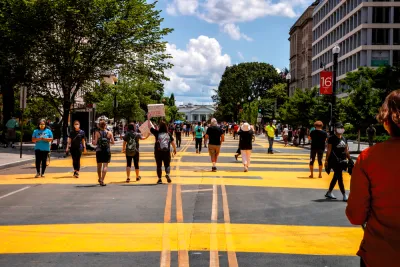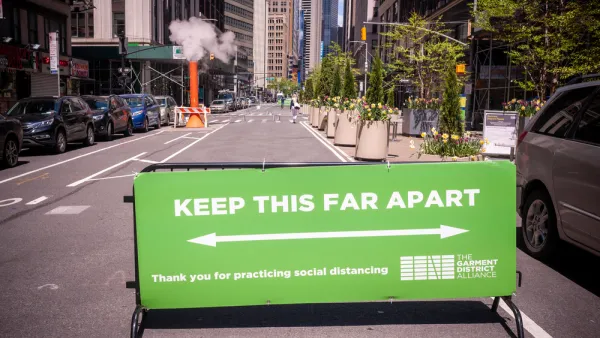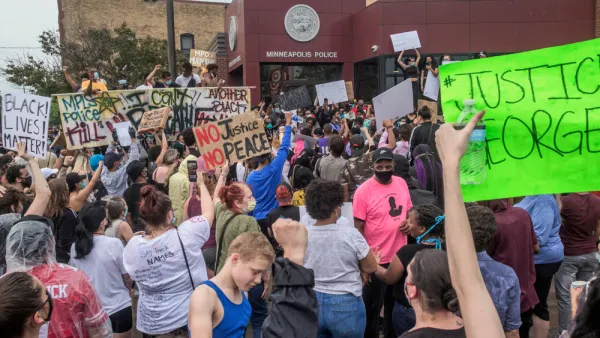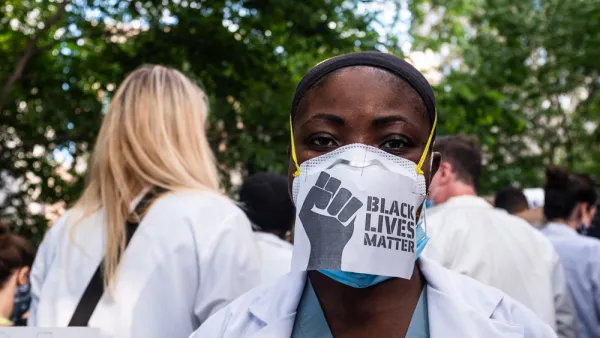A leading advocate for a new, equity centering approach explains how plans to redesign streets for the needs of the coronavirus pandemic left behind racial justice as a secondary concern.

Dr. Destiny Thomas writes for CityLab to explain and illustrate the advocacy for a new kind of attention to be paid to social justice and public safety for Black Americans as planners and advocates press for planning innovations in the public realm.
It's not enough to equate traffic safety and bike and pedestrian and bike infrastructure with social justice, according to Thomas, given the realities of racism in the United States.
The quick deployment of slow streets, al fresco streets, and open streets in the first months of the coronavirus was already raising alarms for Thomas, along with others, before the killings of Ahmaud Arbery and George Floyd shifted public awareness from the pandemic to racial justice:
But to me, as a Black planner and community organizer, the lack of process and participatory decision-making behind these projects was an absolute nightmare. Pop-up bike lanes, guerrilla-urbanist playgrounds, and tactical walkways have been notorious for being politically crude for as long as I’ve been in the field: By design, their “quick-build” nature overrides the public feedback that is necessary for deep community support. Without that genuine engagement, I feared that pandemic-induced pedestrian street redesigns would deepen inequity and mistrust in communities that have been disenfranchised and underserved for generations.
Here, Thomas lays out the fundamental issues that undercut the progressive values intended to manifest in projects that reclaim public space from cars:
The announcement of open streets from Oakland to Minneapolis to New York City left me wondering how advocates for them would respond to data showing Black people make up 87% of those who are being criminalized in the name of “social distancing” in Brooklyn, where Covid-19 is still largely uncontained. Similarly, I thought about the ways Black, Brown, Indigenous People, people of color, as well as trans people, are regularly policed, harassed, and killed in the built environment. That violence could be heightened in spaces where the main understanding of personal safety centers on vehicle traffic, as opposed to valid concerns about racism, transphobia and xenophobia and the territorial entitlement to space that often shows up in newly gentrified communities.
The article is recommended as a clear, authoritative expression of the ideas and causes put forward by the Black Lives Matter movement where it intersects with ostensibly progressive trends in urban planning.
FULL STORY: ‘Safe Streets’ Are Not Safe for Black Lives

National Parks Layoffs Will Cause Communities to Lose Billions
Thousands of essential park workers were laid off this week, just before the busy spring break season.

Retro-silient?: America’s First “Eco-burb,” The Woodlands Turns 50
A master-planned community north of Houston offers lessons on green infrastructure and resilient design, but falls short of its founder’s lofty affordability and walkability goals.

Delivering for America Plan Will Downgrade Mail Service in at Least 49.5 Percent of Zip Codes
Republican and Democrat lawmakers criticize the plan for its disproportionate negative impact on rural communities.

Test News Post 1
This is a summary

Test News Headline 46
Test for the image on the front page.

Balancing Bombs and Butterflies: How the National Guard Protects a Rare Species
The National Guard at Fort Indiantown Gap uses GIS technology and land management strategies to balance military training with conservation efforts, ensuring the survival of the rare eastern regal fritillary butterfly.
Urban Design for Planners 1: Software Tools
This six-course series explores essential urban design concepts using open source software and equips planners with the tools they need to participate fully in the urban design process.
Planning for Universal Design
Learn the tools for implementing Universal Design in planning regulations.
EMC Planning Group, Inc.
Planetizen
Planetizen
Mpact (formerly Rail~Volution)
Great Falls Development Authority, Inc.
HUDs Office of Policy Development and Research
NYU Wagner Graduate School of Public Service





























